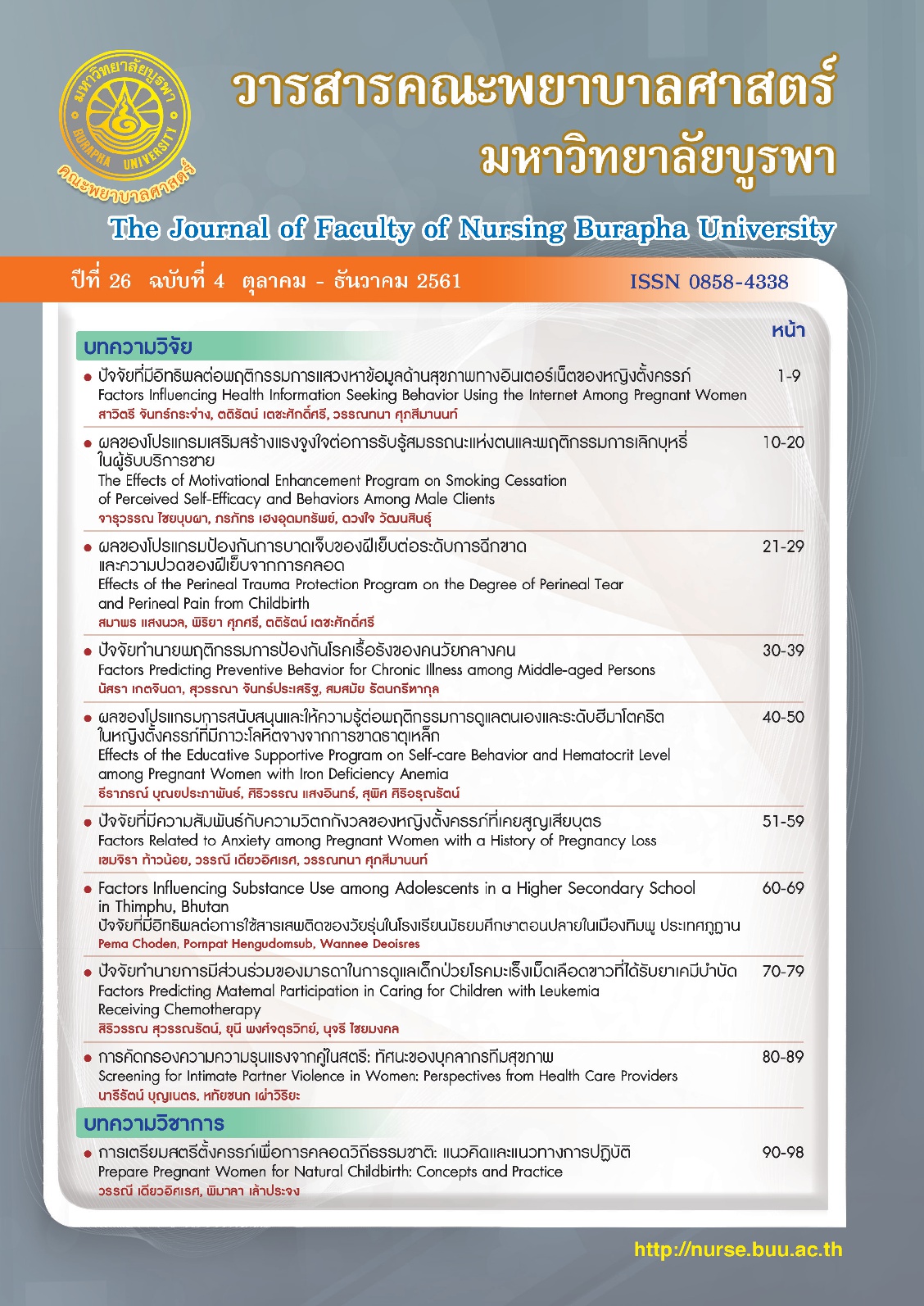ปัจจัยที่มีความสัมพันธ์กับความวิตกกังวลของหญิงตั้งครรภ์ที่เคยสูญเสียบุตร
คำสำคัญ:
ความวิตกกังวล, การสนับสนุนทางสังคม, หญิงตั้งครรภ์, เคยสูญเสียบุตรบทคัดย่อ
บทคัดย่อ
การวิจัยครั้งนี้แบบบรรยายเชิงหาความสัมพันธ์นี้ มีวัตถุประสงค์เพื่อศึกษาปัจจัยที่มีความสัมพันธ์กับความวิตกกังวลของหญิงตั้งครรภ์ที่เคยสูญเสียบุตร กลุ่มตัวอย่างคัดเลือกแบบสะดวกจำนวน 111 ราย เป็นหญิงตั้งครรภ์ที่มีประวัติการสูญเสียบุตรจากการตั้งครรภ์ และการคลอด ที่มารับบริการฝากครรภ์ โรงพยาบาล 3 แห่งในจังหวัดสุพรรณบุรี เก็บรวมรวมข้อมูลเดือนมกราคม-มีนาคม 2561 เครื่องมือที่ใช้ในการวิจัย ได้แก่ แบบสอบถามข้อมูลส่วนบุคคล แบบสอบถามประวัติทางสูติกรรม แบบประเมินการสนับสนุนทางสังคมแบบพหุมิติ และแบบวัดความวิตกกังวลขณะเผชิญ มีค่าความเชื่อมั่นอยู่ระหว่าง .82-.95 วิเคราะห์ข้อมูลด้วยสถิติพรรณนา ค่าสัมประสิทธิ์สหสัมพันธ์ของเพียร์สัน และพอยท์ไบซีเรียล
ผลการวิจัยพบว่า กลุ่มตัวอย่างร้อยละ 49.5 และ 23.5 มีความวิตกกังวลในระดับปานกลาง และระดับสูง ตามลำดับ การสนับสนุนทางสังคมมีความสัมพันธ์ทางลบกับความวิตกกังวลขณะเผชิญอย่างมีนัยสำคัญทางสถิติ (r = -.22, p < .05) ตัวแปรอื่น ได้แก่ อายุครรภ์ของการสูญเสียบุตรในครรภ์ที่ผ่านมา ระยะห่างระหว่างการตั้งครรภ์ครั้งที่แล้ว อายุครรภ์ปัจจุบัน และการมีภาวะแทรกซ้อนระหว่างตั้งครรภ์ไม่พบมีความสัมพันธ์ ผลการศึกษาครั้งนี้ เสนอแนะให้พยาบาลในหน่วยให้บริการฝากครรภ์ มีการประเมินความวิตกกังวลในหญิงตั้งครรภ์ที่เคยสูญเสียบุตร และให้การพยาบาลโดยส่งเสริมให้ครอบครัว เพื่อน และบุคคลรอบข้างของหญิงตั้งครรภ์ ให้การสนับสนุนทางสังคมแก่หญิงตั้งครรภ์เพื่อลดระดับความวิตกกังวลขณะตั้งครรภ์ในครรภ์ปัจจุบัน
เอกสารอ้างอิง
Barber, C. C., & Starkey, N. J. (2015). Predictors of anxiety among pregnant New Zealand women hospitalized for complications and a community comparison group. Midwifery, 31, 888-896.
Bergner, A., Beyer, R., Fertl, K. I., Klapp, B. F., & Rauchfuss, M. (2009). Levels and effects of different forms of anxiety during pregnancy after a prior miscarriage. European Journal of Obstetrics & Reproductive Biology, 142 , 23-29.
Boonyamalik, P. (2005). Epidemiology of adolescent suicidal ideation: Roles of perceived life stress, depressive symptoms, and substance use. Unpublished Dissertation, Johns Hopkins University, USA.
Chambers, J., Glove, V. A., Jayaweera, S. R., King, N. M., O’Donnell, K., & Williamson, C. (2010). Anxiety, depression and saliva cortisol in women with a medical disorder during pregnancy. Archives of Women’s Mental Health, 13(1), 339-345.
Charupronprasit, R., Dumrongchat, M., Sirirat, B., & Suthiart, A. (2016). Statistical Thailand 2016. Nontaburi: Bureau of polocy and strategy, Ministry of public health. [In Thai]
Cheng, E. R., Gillman, M. W., Perkins, M. E., Rich-Edwards, J. W., Rifas-Shiman, S. L., Taveras, E. M., & Wright R. (2016). The influence of antenatal partner support on pregnancy outcomes. Journal of Women’s Health, 25(7), 672–910.
Cote-Arsenault, D. (2003). The influence of perinatal loss on anxiety in multigravidas. Journal of Obstetric, Gynecologic, and Neonatal Nursing, 32, 623-629.
Faul, F., Erdfelder, E., Buchner, A., & Lang, A. G. (2009). Statistical power analyses using G*Power 3.1: Test for correlation and regression analyses. Behavior Research Methods, 41(4), 1149-1160.
Gaudet, C. (2010). Pregnancy after perinatal loss: Association of grief, anxiety and attachment. Journal of Reproductive and Infant Psychology, 28(3), 240-251.
Gong, X., Hao, J., Tao, F., Wang, H., Xu, R., & Zhang, J. (2013). Pregnancy loss and anxiety and depression during subsequent pregnancies: data from the C-ABC study. European Journal of Obstetrics & Gynecology and Reproductive biology, 166(1), 30-36.
House, J. S. (1981). Work Stress and Social Support. Reading. MA: Addison-Westey.
Jonsdottir, S. S., Thome, M., Steingrimsdottir, T., Lydsdottir, L. B., Sigurdsson, J. F., Olafsdottir, H., & Swahnberg, K. (2017). Partner relationship, social support and perinatal distress among pregnant Icelandic women. Women Birth, 30, e46-e55.
Kubler-Ross, E., & Kesster, D. (2007). On grief and grieving. New York, Scribner book.
Loadee, N., Parisunyakul, S., & Sriareporn, P. (2010). Preconception health care for women of reproductive age. The Journal of Faculty of Nursing, Burapha University. 18(2). 51-64.
Nateetanasombat, K., & Suwannasankha, R. (2008). Health problems, unpleasant symptoms, and care demands of pregnant women. The Journal of Faculty of Nursing, Burapha University. 16(4). 62-74.
Robinson, G. E. (2014). Pregnancy loss. Best Practice & Research Clinical Obstetrics and Gynaecology, 28(1), 169-178.
Spielberger, C. D., Gorsuch, R. L., Lushene, R., Vagg, P. R., & Jacobs, G. A. (1983). Manual for the State-Trait Anxiety Inventory. Palo Alto, CA: Consulting Psychologists.
Ugwumadu, A. (2015). Management of stillbirth and perinatal loss. Obstetrics, Gynaecology and Reproductive Medicine, 25(8), 217-221.
Would Health Organization. (2018). World health statistics 2018 monitoring health for the SDGs, sustainable development goals.
Zimet, G. D., Dahlem, N. W., Zimet, S. G., & Farley, G. K. (1988). The multidimensional scale of perceived social support. Journal of Personality Assessment, 52(1), 30-41





